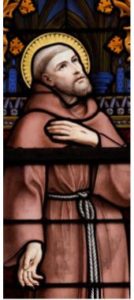(This article originally appeared in the TAU-USA Winter 2019 Issue 99 and the Power Point presentation can be found at Our Father Hail Mary ppt )

St. Francis – Stained Glass in the Cathedral of Brussels created in 1866
HIGHLIGHTS OF NATIONAL CHAPTER
As followers of Francis and Clare, their prayer life inspires us to a deeper relationship with God. But how did they open their hearts and souls? How did they converse with the Almighty, All powerful Lord of all?
National Formation Commission Team members — Francine Gikow, OFS, Anne Mulqueen, OFS, Layna Maher, OFS and Mary Stronach, OFS – took National Chapter attendees on a personal journey of prayer, inspired by the prayer life of Francis and Clare.
DAY 1 FORMATION
PRAYING AS FRANCIS DID
Anne began with the beloved prayer before the San Damiano Cross – the only one in which Francis prayed for his own discernment. She explained that Franciscan prayer has some “common threads:”
- All place the Eucharistic celebration above all other forms of prayer.
- The Divine Office holds a place of prominence in daily prayer life.
- Prayer is Trinitarian in focus and centered on the life and teachings of Christ in the gospels.
- Contemplative prayer is essential and leads to action.
As Francis grew and matured in his faith, his prayers also become more creative. As an example, she introduced the Office of the Passion, probably the least known of Francis’ writings. “The 15 Psalms are a composite of various verses of the Davidic psalms and other part of Scripture. Francis began his office with his original prayer inspired by the Our Father (Our Father Most Holy… Gloria …) After the Our Father, he prayed the Praises to be Said at All Hours, followed by his antiphon honoring the Blessed Virgin Mary.” The office concludes with a refrain that Franciscans often sing: “Let us bless the Lord, the living and true God; to Him let us always render praise, glory, honor, blessing and every good. So be it. So be it. Amen.”
During the Office, we hear the Hero (Jesus Christ) addressing His father and the people. Occasionally, Francis intercedes and addresses the people. He closes with a hymn of praise for the Hero’s origin and birth, reminiscent of Greccio.
Anne Mulqueen, OFS, and Mary Stronach, OFS

Anne next discussed the Canticle of Creatures. She emphasized the last two stanzas on reconciliation, peace and death, repeating part of the prayer: “Praised be You, my Lord, through those who give pardon for your love, and bear infirmity and tribulation. Blessed are those who endure in peace for by You, Most High, shall they be crowned.”
The second part of the session, presented by Mary, continued Francis journey in prayer — prayer which “changed him,” she said, quoting St. Bonaventure, “The encounter with Christ, as other, gave Francis a new openness and freedom. Embraced by the compassionate love of God, Francis was liberated within and went out to embrace others in love.” As people of prayer, she challenged, “Does my prayer change me, liberate me? Does it make me better?”
In a prayer exercise, attendees took time to read and contemplate the words which Francis used when he would say the “Our Father.”
As a follow-up to this exercise, attendees became co-authors in another prayer, The Hail Mary. During a 10-minute session of private meditation and personal conversation with Mary, their task was to write the Hail Mary as Francis might have: to add a meaningful and personal message to each line of the prayer.
Some shared their newly written version of the Hail Mary, acknowledging that the experience had opened their hearts to a deeper relationship with Mary.
( NEXT BLOG — DAY 2 FORMATION – PRAYING AS CLARE DID)


Leave A Comment